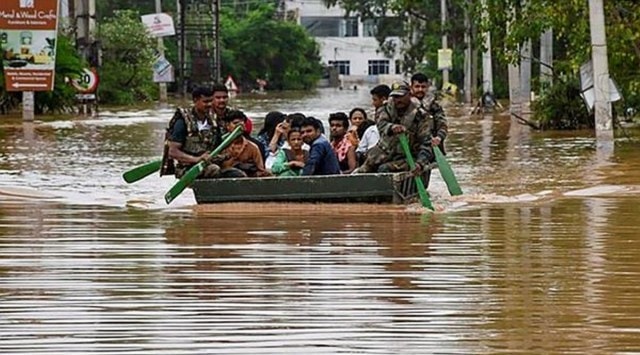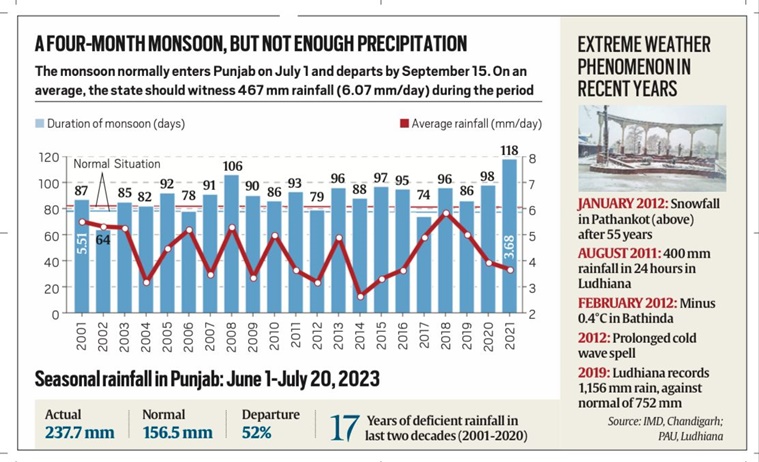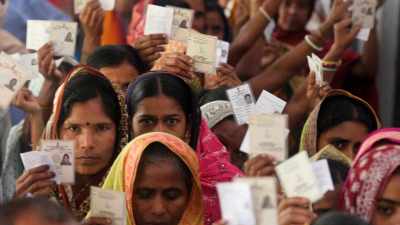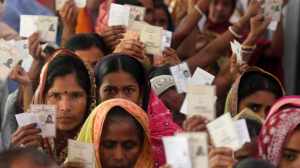Stay updated with the latest - Click here to follow us on Instagram
Climate change sign spells trouble for Punjab: Longer monsoon, lesser rain in past two decades, says PAU study
Truant rain, indiscriminate pumping out of groundwater pushing Punjab to desertification, says study
 The study further notes that the recent changes in rainfall pattern have led to “a shift of the climate of Indo-Gangetic plains (IGP) and northeast India” towards a relatively arid regime. (PTI)
The study further notes that the recent changes in rainfall pattern have led to “a shift of the climate of Indo-Gangetic plains (IGP) and northeast India” towards a relatively arid regime. (PTI) From sudden and heavy bursts of rain in short duration to snowfall in an area that had no such previous record, and from a gradual increase in the minimum temperature to monsoon that now stretches to nearly four months but with lesser rain — the signs of climate change are now clear and visible in Punjab. The truant monsoon rain combined with cultivation of water guzzling crops, and lack of crop diversification along with indiscriminate pumping out of groundwater is “pushing the water scare state towards a water deficit desert”, suggests research by the Punjab Agricultural University (PAU).
The scientists from department of climate change and agricultural meteorology at the Ludhiana-based university, who studied the monsoon data and patterns over past five decades (1971-2020), found that monsoon is now staying for more days in Punjab but the amount of rainfall being received is decreasing and is unevenly distributed.
The study — “A case study on the changing pattern of monsoon rainfall duration in different agroclimatic zones of Punjab” — by senior agro meteorologists Sarabjot Kaur Sandhu and Prabhjyot Kaur notes that changes in Punjab’s monsoon pattern have aggravated in past two decades (2001 onwards).

“During the monsoon season, paddy is the main crop grown in the state. The area under paddy has increased from 0.6 Mha during 1970 to 3.01 Mha during 2018, an increase by 400 per cent. To irrigate this water guzzling crop, farmers are dependent either on monsoon rainfall or on underground water. But over the last two decades, the duration of monsoon currents has increased but the rate of rainfall is well below the average of 6 mm/day. Also, the distribution of the rainfall during the season is highly variable during the four months. The sudden and heavy shower of rainfall received in a short span of time is not only declining the water productivity of crops but also hampering the recharging of underground aquifers,” says the study.
“In an ideal situation, the low intensity of rainfall is a booster for the growth of crops as well as for the recharging of the underground aquifer. But the declining trend of rainfall in the north eastern regions of the state lying in the foothills of Shivalik is redefining the average distribution of rainfall in the region. The abrupt changes in the monthly distribution of monsoon rainfall… during the months of June, July, August and September respectively is also not helping the situation as less rainfall during June and July causes a drain on the ground water resources. Later during the end of the season, heavy rainfall during September along with an extension in monsoon currents delay the maturity and hamper harvesting of the paddy crop. The cumulative effect of truant monsoon rainfall, very high cropping intensity and indiscriminate pumping out of underground water is pushing the water scarce state towards a water deficit desert,” it says.
The study further notes that the recent changes in rainfall pattern have led to “a shift of the climate of Indo-Gangetic plains (IGP) and northeast India” towards a relatively arid regime. “Punjab, which is a part of IGP, already has a semi-arid and subtropical climate… As the signals of climate change become more and more significant, changes in temperature and rainfall pattern and their extremes are being recognized and reported worldwide”.
The analysis of the data of amount of monsoon rainfall and calculation of per cent departure from normal rainfall revealed that of past 20 years (2001-2020), there was deficient monsoon rainfall in 17 years.
The analysis indicates that during the five decades (1971-2020) of study, Punjab received deficient rainfall in 28 years. In 17 years out of the recent two decades (2001-2020), Punjab had deficient monsoon rainfall, even though the duration of monsoon current was more than the normal 77 days. “So, in recent years the monsoon rainfall has declined in the state at a faster rate,” says the study.
Prabhjyot Kaur said that the study shows that amount of rainfall being received has significantly decreased in past two decades and the monsoon pattern is disturbed and spells bad news for Punjab, which has moved to “paddy-wheat mono-cropping cycle”.
“It’s a double whammy for Punjab as the disturbed monsoon pattern is putting stress on already stressed underground water on which farmers depend for irrigating paddy through tubewells,” she said.
Paddy cultivation also leads to production of methane gas, which is a powerful greenhouse gas contributing in climate change.
“The sudden and heavy spells of rainfall are also declining water productivity of crops, which means that water being received via rainfall is not being put to optimum use but is going waste,” she added.
Days when mercury crosses 40°C-mark rising
A study on daily temperature from 1970 to 2019 by PAU — “Climate Change in Punjab-Some Facts” — has revealed that “on an average the number of days with temperature higher than 40° Celsius has increased” in Punjab. “The maximum number of days with temperature higher than 40° C was observed at Bathinda (1980-89 and 2010-19) followed by Amritsar and Patiala,” says PAU publication.
Similarly, the number of days with temperature below 2 ° C has decreased in Punjab. “During the past, the highest number of days with temperature below 2°C was observed at Amritsar (during 1980-89 and 2000-2009) followed by Bathinda,’ it adds.
A significant increase in annual minimum temperature was noticed at Ludhiana, Amritsar, Patiala and Bathinda from 1970 to 2019.
“The increasing trend in minimum temperature in Punjab indicates that there is need for awakening by not only the agricultural sector but also by the industry and allied sectors to check this increasing rate. Also in times to come the productivity of major food crops may be severely affected, if no mitigation and adaptation strategies are undertaken,” says the study.













